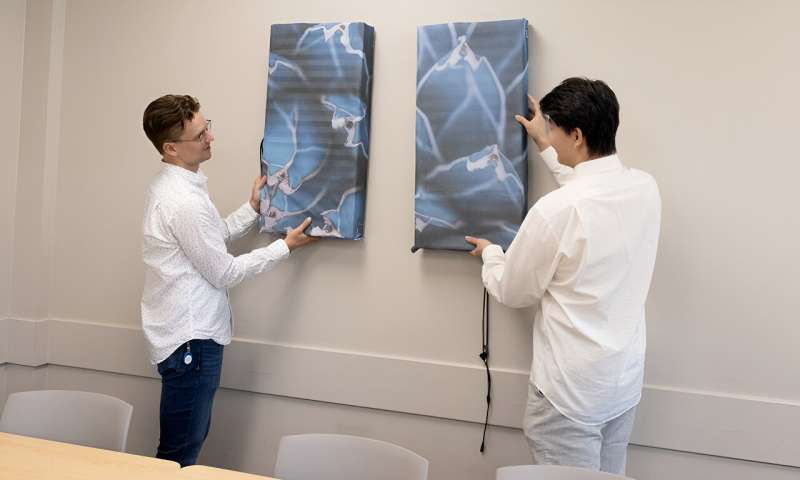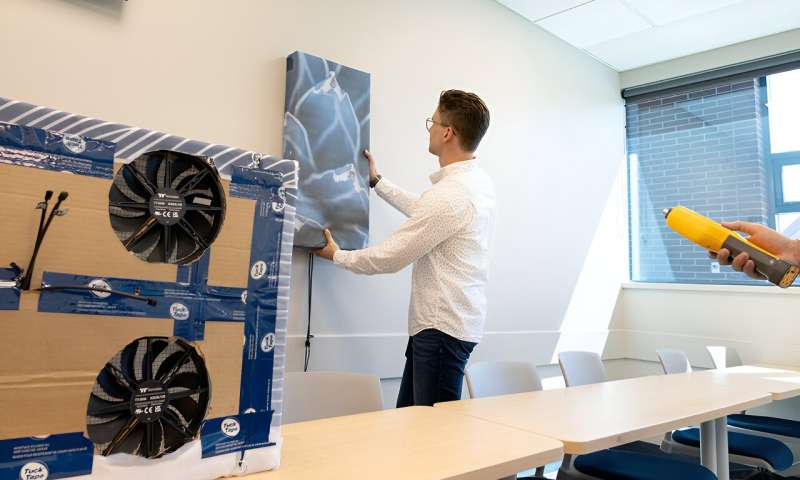
Chances are you've never considered the act of breathing. Our lungs' gentle rise and fall is autonomic, pulling air in and nourishing our body with oxygen before expelling wastes like carbon dioxide (CO2).
But have you ever thought of all the other microscopic molecules floating through the air, also making their way into your lungs and body?
"We now know that any particulate matter smaller than 2.5 microns—about 30 times smaller than a strand of hair—can get deep into your lungs, which becomes a health concern," explains Dr. Jonathan Little, Professor of Health and Exercise Sciences at UBC Okanagan.
Whether it's viruses, bacteria, pollen, car exhaust or wildfire smoke—to name a few—sometimes our air isn't as clean as it could be.
That's where UBC Okanagan's Aerosol Removing Tapestry—or ART—comes in.

Cleaner air with ART: Transforming indoor air filtration
It looks like any other painting hanging on a wall, but positively charged filters from community partner C-Polar Technologies quietly removes airborne particles and bacteria in the room underneath an artistic mesh fabric "canvas."
Developed by Dr. Little and Dr. Sunny Li's Airborne Disease Transmission Cluster, the device is a low-cost, quiet, and customizable alternative to current filtration devices on the market—many of which are large, loud and sometimes unsightly.
"Air filtration devices aren't new, but we're trying to create a more practical solution to achieve cleaner air. ART is wall-mounted, modular and quiet. It's almost like it's built into the room," says Dr. Li, a Professor of Mechanical Engineering, the cluster's lead researcher and head of its Technology, Research and Development team.
"As a team, we have a lot of questions for the research to answer," he adds. "Essentially, how we can enhance indoor air quality across our campus and extend our findings to other sites like hospitals?
"And, secondly, would people be interested in and use a practical solution like ART in their home or office?"
After evaluating indoor spaces at the university with the highest risk of viral spread and potential inhalation of pollutants via CO2 measurements, cluster team members will use the information to test different ART sizes and locations, monitoring its effect on air quality in the room.
The research is timely and relevant—not only in Canada but around the world—as an estimated 99 percent of human beings currently breathe air that exceeds the World Health Organization's guideline limits for pollutants.
Indoor and outdoor air pollution is responsible for nearly seven million deaths annually.
"COVID-19 was the first time that questions about airflow and air quality received so much attention," says Dr. Little. "But just because the immediate concern of COVID-19 is over doesn't mean we should stop that research or stop thinking about indoor airflow.
"We still have wildfires, vehicle exhaust and production emissions that pollute our air and negatively impact millions. That's why issues of airflow and indoor air quality are crucial to understand."

Interdisciplinary work provides global solutions
Such questions can't be answered without an interdisciplinary approach.
According to Jake Winkler—the cluster's Research Coordinator—the whole project would be much more difficult at an institution other than UBC Okanagan, which is currently the only university in BC investigating indoor airflow in this manner.
"We're a close-knit campus that prioritizes research, so we can more effectively bring together diverse experts to provide different perspectives. On a subject as complex as indoor airflow, no single academic discipline can solve this problem."
The cluster features UBC researchers from medicine; engineering; health and exercise sciences; and community partners like C-Polar Technologies and Interior Health. Through UBC Okanagan's Campus as a Living Lab initiative, UBC Okanagan's Facilities Management and Health, Safety and Environment offices are also on board.
"Ultimately, everyone is affected in one way or another by air pollution and indoor air quality, so we're not only seeking an answer for our campus but, one day, for the globe."
Campus as a Living Lab partners UBC researchers with campus operations staff to devise and implement innovative solutions to on-campus challenges. The cluster effectively bridges the difficult gap between theoretical, fundamental research and tangible results.
"These kinds of studies are always exciting because there can be research outcomes that provide positive health results down the road," says Dr. Li.
"Ultimately, everyone is affected in one way or another by air pollution and indoor air quality, so we're not only seeking an answer for our campus but, one day, for the globe."
Citation: Breathing easier thanks to ART: Engineers take unique approach to tackle indoor air quality (2024, August 19) retrieved 19 August 2024 from https://techxplore.com/news/2024-08-easier-art-unique-approach-tackle.html
This document is subject to copyright. Apart from any fair dealing for the purpose of private study or research, no part may be reproduced without the written permission. The content is provided for information purposes only.
